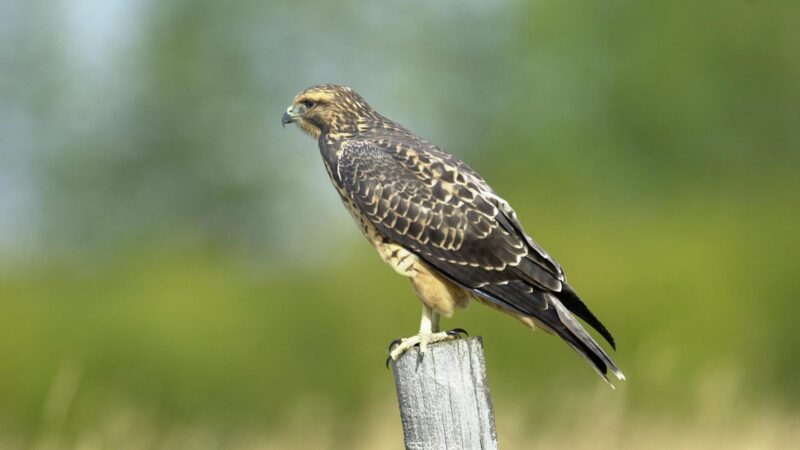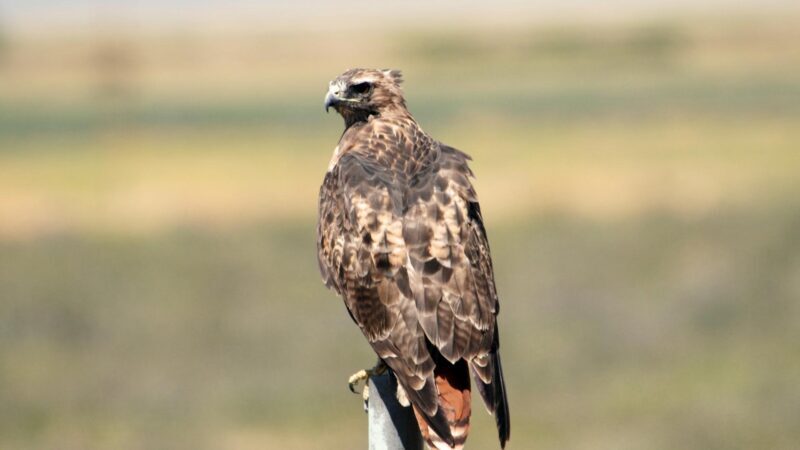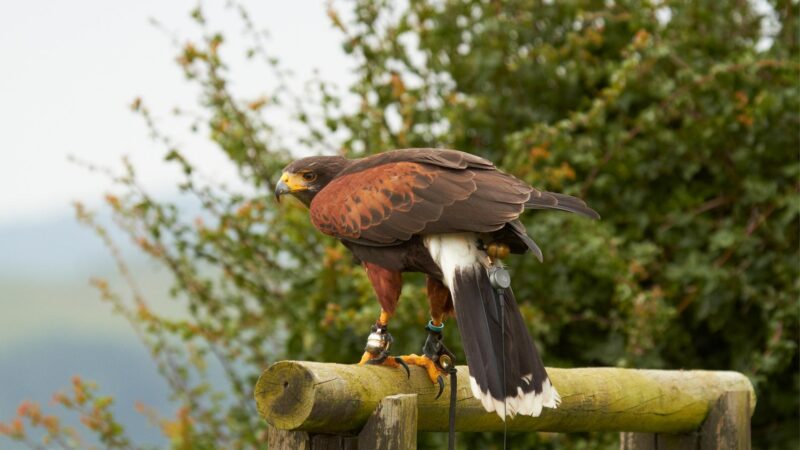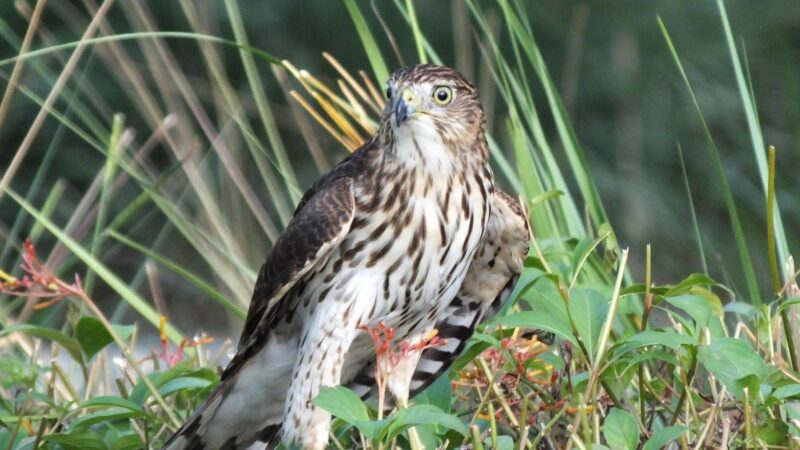Also referred to as raptors, birds of prey hunt and feed on small animals. They’re a group of intelligent birds with sharp eyesight, tough talons, and hooked beaks. Pennsylvania currently hosts 414 species of wild birds that are either regular citizens, casual visitors, or accidental tourists.
These include the Bald Eagle, American Kestrel, Rough Legged Hawk, Turkey Vulture, Golden Eagle, Red-tailed Hawk, Harris’s Hawk, and many more, for a total of 17 species.
If you want to know more about these apex predators, how long they could live, body proportions, preferred food intake, places of origin, and other interesting characteristics, read further this article!
Table of Contents
Where Are Hawk Birds Found?
Hawks are found on every continent except Antarctica and are mostly located in oceanic islands. They live in almost every biogeographic region, particularly in terrestrial habitats found in the tropics. They, however, don’t inhabit arctic tundra and extremely dry deserts.
Regardless of species, they are largely found in woodlands and forests where productivity and tree populations are high.
17 Birds of Prey Found in Pennsylvania
Bald Eagle

Bald eagles are one of the largest birds of prey. They prefer to sit and wait before pouncing on their prey. They were once considered endangered species. But thanks to persistent conservation efforts, they’re now in abundance.
- Scientific Name: Haliaeetus leucocephalus
- Appearance: Adults have white heads and tails while younger birds have dark brown colors with white mottling.
- Lifespan: 15 to 20 years (wild), 20 to 30 years (captivity)
- Size: 2.6 to 3 feet
- Weight: Up to 14 pounds
- Wingspan: 5.8 to 7.5 feet
- Diet: Fish, water birds, small mammals, carrion, turtles, human waste
- Place Of Origin: North America
- Characteristics: Bald eagles fly with their wings at right angles and their bodies flat. This is often referred to as a “flying plank” by bird watchers.
American Kestrel

American kestrels are known to peacefully coexist with humans and landowners as they are effective insect-catchers and prey on small pesky mammals that destroy plants. They are the smallest falcons and are typically solitary birds except during mating season.
- Scientific Name: Falco sparverius
- Appearance: Undersides have a tawny, yellowish color with dark streaking. Backs and tails have a rusty, brick hue, also with dark spots or patterns. Two dark eye spots on the back of its head and two dark stripes on the front of its face.
- Lifespan: 5 to 17 years (captivity), Up to 11 years (wild)
- Size: 8.7 to 12.2 inches
- Weight: 2.8 to 5.8 ounces
- Wingspan: 20 to 24 inches
- Diet: Insects, worms, small birds and mammals, snakes, and frogs
- Place Of Origin: North and South America
- Characteristics: Naturally territorial and aggressive against other birds. They like to take dust baths and are known to “klee,” which is a bird sound for excitement or distress.
Rough-Legged Hawk

Rough-legged buzzards are migratory predators who fly to cold, Southern regions for forage grounds during the winter season. They occasionally steal other birds’ prey, even directly from their talons.
- Scientific Name: Buteo lagopus
- Appearance: Body color can range from dark to light, with dark splotches all over the body and wings and a light band on the tail.
- Lifespan: 2 to 18 years (wild), Up to 24 years (captivity)
- Size: 18 to 23 inches
- Weight: 26.3 to 48.6 ounces
- Wingspan: 48 to 56 inches
- Diet: Small rodents, prairie dogs, squirrels, and carrion
- Place Of Origin: Arctic tundras of North America, Canada, Europe, and Asia
- Characteristics: The term “rough-legged” is used to refer to its tarsi or the feathers found in its lower legs which are uncommon among raptors.
Turkey Vulture

With a sharp sense of smell, turkey vultures can detect carcasses easily. Their bare heads and necks are evolutionary traits that they’ve adopted to avoid dirtying their feathers when feeding. They’re known to be unsteady travelers and only perform a few wingbeats.
- Scientific Name: Cathartes aura
- Appearance: Reddish or pinkish unfeathered heads with brownish-black plumage and silver gray underwings.
- Lifespan: Up to 17 years (wild)
- Size: 25.2 to 31.9 inches
- Weight: 1.9 to 4.4 pounds
- Wingspan: 66.9 to 72.1 inches
- Diet: Small mammals, dead cows, road-killed animals, insects, fruit
- Place Of Origin: Southern Canada, Southernmost tip of South America, Caribbean
- Characteristics: Independent foragers but will roost with large groups. When flying, their wings make a V shape.
Golden Eagle

Known as the national symbol of Mexico, golden eagles are occasional guests in Pennsylvania, mostly during the winter season, due to the ideal forest terrains of the state. They’re the second largest raptors next to bald eagles.
- Scientific Name: Aquila chrysaetos
- Appearance: Bodies have primarily dark brown colors, golden-hued plumage and backs of heads, and grayish brown tails.
- Lifespan: Up to 32 years (wild), Up to 46 years (captivity)
- Size: 27.6 to 33.1 inches
- Weight: 105.7 to 215.9 ounces
- Wingspan: 72.8 to 86.6 inches
- Diet: Small rabbits, birds, reptiles, fish, seals, coyotes, badgers, and carrion
- Place Of Origin: North America and Mexico
- Characteristics: Solitary birds, but may come in pairs when hunting for food or group with others during winter and other extreme weather conditions.
Red-Tailed Hawk

Naturally antagonistic with other bird species, including raptors, red-tailed hawks have sharp eyesight that enables them to locate mice 100 feet from the ground. Their cries are popularized in film media and are used for any hawk or eagle sounds.
- Scientific Name: Buteo jamaicensis
- Appearance: Their bodies can be varying shades of brown, with their underbelly having a lighter color and dark bands across. Their tails are reddish, hence the name.
- Lifespan: Up to 21.5 years (wild), Up to 29.5 years (captivity)
- Size: 17.7 to 25.6 inches
- Weight: 28 to 43.1 ounces
- Wingspan: 48 to 49 inches
- Diet: Small rodents, red-winged blackbirds, reptiles, snakes, insects, small to medium-sized mammals, and fresh carrion
- Place Of Origin: Nearctic regions in the US, Canada, Mexico, and Central America
- Characteristics: Territorial birds may resort to aggression as a self-defense mechanism. They’re diurnal and communicate primarily through body language.
Harris’s Hawk

Highly social predators who like to cooperatively hunt and nest with groups made of 2 to 7 individuals, harris hawks typically hunt for and share larger-sized prey. They often get electrocuted—a bad habit they can’t shake.
- Scientific Name: Parabuteo unicinctus
- Appearance: Overall dark brown plumage with distinguishable reddish shoulders, legs, and wings.
- Lifespan: 10 to 15 years (wild), 20 to 25 years (captivity)
- Size: 18.1 to 29.9 inches
- Weight: 25.9 to 36.9 ounces
- Wingspan: 39.4 to 47.2 inches
- Diet: Rats, mice, small birds, lizards, cottontails, jack rabbits, and squirrels
- Place Of Origin: Semi-open regions in Southwestern USA, South Mexico, Central, and South America
- Characteristics: Non-migratory birds that are diurnal and territorial. They’re generally fast flyers and adhere to a hierarchy led dominantly by an alpha female.
Sharp-shinned Hawk

Sharp-shinned hawks are the smallest hawks in North America. They like to adopt an ambush hunting strategy where they perch in an inconspicuous location to hide from prey and then pounce unsuspectingly.
- Scientific Name: Accipiter striatus
- Appearance: Gray-shaded upper parts with reddish-brown underparts. Their tails are square-shaped with a white band. They have short and round wings.
- Lifespan: 3 to 13 years (wild)
- Size: 9.5 to 13.4 inches
- Weight: 3.1 to 7.7 ounces
- Wingspan: 20.9 to 25.6 inches
- Diet: Small mammals, large insects, and various species of birds, especially nestlings
- Place Of Origin: North America, Venezuela, Northern Argentina
- Characteristics: Diurnal, migratory, and territorial birds are typically solitary but can form small groups during migration.
Barn Owl

The most common birds in the world, barn owls are medium-sized owls that have great hunting skills with the use of their keen sense of sound and night vision. They use various vocalizations to communicate and can also perceive physical language.
- Scientific Name: Tyto alba
- Appearance: Large, heart-shaped faces with no ear tufts. Rounded wings and white to pale brown plumage with black and white spots.
- Lifespan: 1.7 to 34 years (wild)
- Size: 12.6 to 15.8 inches
- Weight: 15.2 to 21.9 ounces
- Wingspan: 42.1 to 43.3 inches
- Diet: Primarily rodents, small mammals and birds, lizards, insects
- Place Of Origin: All continents except Antarctica, depending on the subspecies
- Characteristics: Nocturnal birds who are either independent or part of pairs. Most of them are sedentary, but some are also migratory.
Barred Owl

Unlike typical owls, they’re active during the day, although they were once nocturnal predators. They’re referred to as hoot owls because they hoot as a main form of communication. They also perch hunters and like to swoop in for the kill.
- Scientific Name: Strix varia
- Appearance: Round-headed with stocky bodies, no ear tufts, and primarily grayish-brown features, Their underparts are streaks of white and brown.
- Lifespan: Up to 18 years (wild)
- Size: 18.9 to 20.1 inches
- Weight: 1.3 to 1.8 pounds
- Wingspan: 42.1 to 43.7 inches
- Diet: Rabbit-sized mammals, birds, fish, amphibians, reptiles, invertebrates
- Place Of Origin: Eastern to Western North America
- Characteristics: Sedentary unless there is a food shortage, which causes them to look for prey. Solitary but calls on other individuals if their territories are disturbed.
Eastern Screech Owl

Extremely vigilant raptors who will resort to violence when interfered with by predators, eastern screech owls differ from their western relatives by their distinctive trill calls. Since they have symmetrical ears, they hunt using their keen sense of sight by waiting on tree branches.
- Scientific Name: Otus asio
- Appearance: Has reddish-brown and gray color morphs, unlike any other North American owl. They have ear-tufts and greenish bills.
- Lifespan: Up to 14 years (wild), Up to 13 years (captivity)
- Size: 6.3 to 9.8 inches
- Weight: 5.78 ounces
- Wingspan: 19 to 24 inches
- Diet: Nocturnal insects, crayfish, worms, small mammals and birds, amphibians, reptiles
- Place Of Origin: Eastern North America
- Characteristics: They hop or walk when chasing prey on the ground. They’re non-migratory and solitary unless it’s mating or winter seasons.
Peregrine Falcon

Peregrine falcons adopt an airborne hunting style where they swoop to catch and kill prey during flight. They’re mostly found nesting on bridges and tall buildings in Pennsylvania. It was considered a threatened species until it was deemed safe in September 2021.
- Scientific Name: Falco peregrinus
- Appearance: Upper parts and pointed wings are shades of bluish gray while undersides are pale, with bluish-gray bar patterns.
- Lifespan: 13 to 20 years (wild), Up to 25 years (captivity)
- Size: 14.2 to 22.8 inches
- Weight: 29.6 to 32 ounces
- Wingspan: 35.8 to 44.1 inches
- Diet: Primarily birds with doves and pigeons making up the bulk of their diet, bats, rodents, squirrels, and rats.
- Place Of Origin: Australia
- Characteristics: Diurnal predators that are solitary and territorial. Vocalizations are usually voiced during the breeding season.
Osprey

Has an eagle-like appearance, ospreys are usually found in major rivers and shallow bodies of water, mostly in lakes and reservoirs, in Pennsylvania, where they can hunt for fish. They’re known to have failures during reproduction due to the ingestion of harmful chemicals.
- Scientific Name: Pandion haliaetus
- Appearance: Dark brown on the upper part and white on the lower part of the plumage. The head is white with black patches on the cheeks.
- Lifespan: Up to 25 years (wild)
- Size: 21.7 to 22.8 inches
- Weight: 42.3 to 70.5 ounces
- Wingspan: 57.1 to 66.9 inches
- Diet: Ospreys are piscivores who largely prefer live fish, but they also eat muskrats, snakes, squirrels, salamanders, squirrels, and voles.
- Place Of Origin: Oceania and Australia
- Characteristics: Can be either migratory or sedentary, and solitary or involved in small colonies. They’re not very territorial as they only defend their nesting sites.
Long-Eared Owl

Long-eared owls are not permanent residents of Pennsylvania as they’re migratory predators. They band together in roosts during distressing times of the year. Currently, it’s a threatened species under a high level of concern in the state.
- Scientific Name: Asio otus
- Appearance: Brownish gray plumage with vertical streaks, blackish narrow ear tufts, and long wings and tail
- Lifespan: 9 to 27 years (wild)
- Size: 13.8 to 15.8 inches
- Weight: 7.6 to 15.3 ounces
- Wingspan: 35.4 to 39.4 inches
- Diet: Volees, deer mice, kangaroo rats, shrews, and other small mammals that weigh less than 100 grams
- Place Of Origin: North America, Europe, East Japan
- Characteristics: Shy and nocturnal predators who take advantage of their slender bodies to hide from other predators and prey.
Great-Horned Owl
Great-horned owls are silent killers as they are nearly soundless during flight. They have flexible upper necks that can rotate at a 180° angle. They’re notorious for predating on other owl species.
- Scientific Name: Bubo virginianus
- Appearance: Rounded faces with dark, horn-shaped feather tufts on top of their head, white underparts, and brownish gray plumage with horizontal streaks.
- Lifespan: 13 to 28 years (wild), 20 to 35 years (captivity)
- Size: 18 to 25 inches
- Weight: 3.7 pounds (females), 2.9 pounds (males)
- Wingspan: 50 to 60 inches
- Diet: Hares, pikas, rabbits, voles, insects, skunks, fish, crustaceans, reptiles, amphibians
- Place Of Origin: North America
- Characteristics: Solitary creatures who engage in disputes over territories with other owls. Non-migratory, but they tend to move around the same area.
Northern Saw-Whet Owl

Known to be the smallest bird of prey found in North America, Northern saw-whet owls use a perch and wait approach when hunting and tend to store and freeze food during the winter season.
- Scientific Name: Aegolius acadicus
- Appearance: Round heads and a pale-colored face with brown outlines and patterns. The upper parts are covered in white and brown spots.
- Lifespan: Up to 7 years (wild), Up to 16 years (captivity)
- Size: 7.1 to 8.5 inches
- Weight: 2.3 to 8.9 ounces
- Wingspan: 17.7 to 23.4 inches
- Diet: Mice, voles, shrews, lemmings, chipmunks, squirrels, insects, small birds
- Place Of Origin: North America
- Characteristics: Nocturnal, solitary, and migratory predators who use hearing primarily for prey detection.
Cooper’s Hawk

Chasing prey at high speeds, either by flying or on foot, cooper’s hawks are known to suffocate their prey by squeezing or drowning them in water. These vicious predators are widespread in Pennsylvania during migration season.
- Scientific Name: Accipiter cooperii
- Appearance: Gray heads, reddish brown under parts, and long-rounded tails and wings
- Lifespan: 1.3 to 12 years (wild)
- Size: 13.8 to 19.7 inches
- Weight: 9.9 to 20 ounces
- Wingspan: 29.5 to 37 inches
- Diet: Red-winged blackbirds, starlings, bobwhites, chipmunks, squirrels, reptiles, amphibians
- Place Of Origin: North America
- Characteristics: Diurnal raptors who prefer staying in woodlands and use a perch and wait strategy for prey. Migratory birds are solitary except during breeding seasons.
Frequently Asked Questions
What Is the Largest Bird in Pennsylvania?
The Sandhill crane is the largest bird in the state which can grow up to 4 feet in height and have a 7-foot wingspan. They’re characterized by varying shades of red, brown, and gray on their bodies and plumage. The bald eagle, on the other hand, is the largest bird of prey in the state.
What’s the Smallest Bird of Prey?
Black-thighed falconet is the smallest bird of prey in the world, measuring only 5.5 to 6.3 inches in size with a wingspan of 10.6 to 13.4 inches, weighing only 1 to 2 pounds. On the other hand, Northern Saw-Whet Owl is the smallest raptor in Pennsylvania.
What Does It Mean if a Hawk Is in Your Yard?
Yards may attract hawks due to the presence of trees and other landscape structures such as fields, shrubs, and bushes. It may also be responding to a potential nesting or roosting spot found in yards. If your yard is near a forested area or an open space, it may be attracted to the prey they find there.
Are Owls Friendly?
Owls are friendly, as they are solitary and territorial creatures. Some species, however, like the Western Screech Owls, are friendly to humans.
What Attracts Owls to Your House?
Owls are attracted to man-made nesting sites such as nest boxes attract owls. Especially if they’re placed in a dark, secluded areas near your house, such as in croplands, grasslands, and generally open-spaced habitats.
Summary
There are a total of 17 species of birds of prey found in Pennsylvania that largely hunt and feed on small mammals, reptiles, amphibians, fish, and insects.
Most of them are regular citizens of the state, but some are also casual and migratory birds. The largest raptor in the state is the Bald Eagle, while the Northern Saw-Whet owl is the smallest.
List of Sources
Siciliano Martina, L. (2013). Haliaeetus leucocephalus. Animal Diversity Web.
Townes, S. (2014). Falco sparverius. Animal Diversity Web.
Good, G. (2008). Buteo lagopus. Animal Diversity Web.
Yeager, A. B., Brittingham, M. C. (2013). Managing Habitat for American Kestrels. PennState Extension.
Gross, D., Brauning, D. Bald Eagle. Pennsylvania Game Commission.
